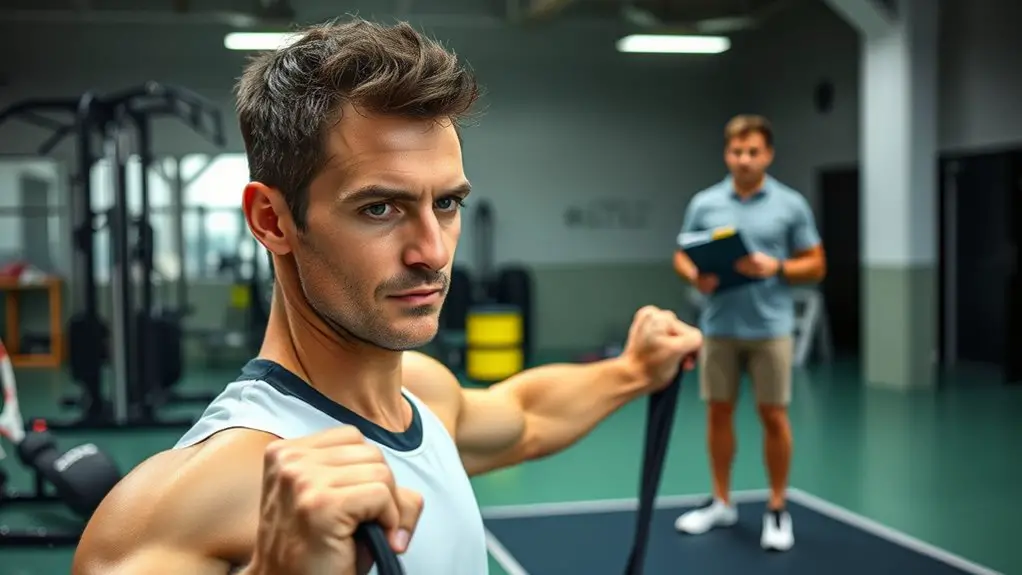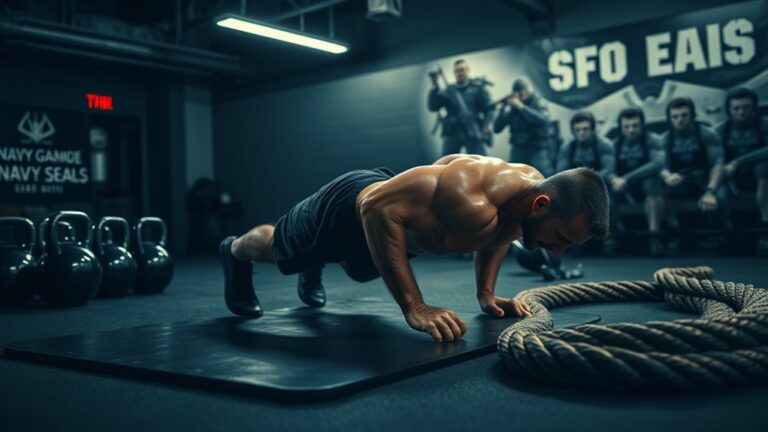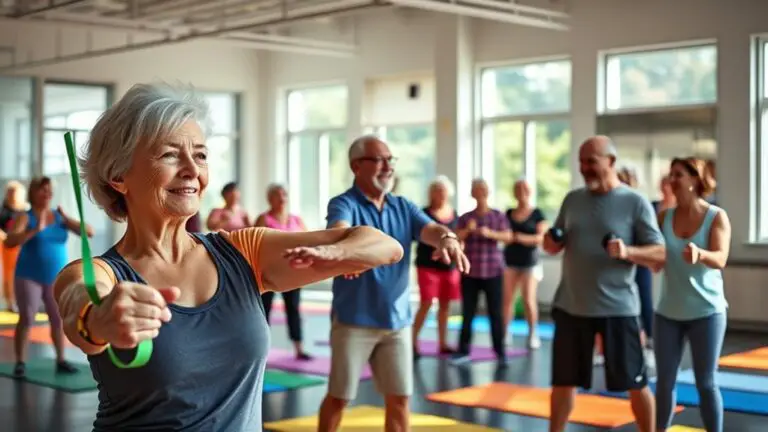How Gym Training Helps Tennis Players Improve Their Game

Gym training helps you improve your tennis game by building strength, endurance, and agility. Through targeted workouts, you enhance your core stability and explosive power, crucial for serves and returns. You also develop your footwork and cardiovascular fitness, allowing you to maintain energy during long matches. Additionally, strength training minimizes injury risks and supports recovery. Integrating these elements into your routine can elevate your performance. There’s much more to explore about how you can maximize your training!
The Importance of Strength Training for Tennis Players

While you might think of tennis as primarily a skill-based sport, strength training is essential for enhancing your performance on the court. By incorporating strength training techniques into your routine, you’ll build the power and endurance needed for those long rallies and explosive serves. The strength training benefits are numerous; not only does it improve your overall physical condition, but it also helps prevent injuries.
Focusing on exercises that strengthen your core, legs, and arms can enhance your stability and control during matches. Bodyweight exercises, resistance bands, and weights can all be effective when done safely and with proper form. Remember to start slow and consult a trainer if you’re unsure about any movements. Prioritizing strength training will not only elevate your game but also keep you healthy and injury-free, allowing you to enjoy tennis for years to come.
Enhancing Agility and Footwork Through Gym Workouts
To excel in tennis, enhancing your agility and footwork is essential, as these skills allow you to respond quickly to your opponent’s shots. Incorporating gym workouts into your training can greatly improve these attributes. Focus on speed drills that challenge your quickness and reaction time. For instance, cone drills can help you practice lateral movements, mimicking the side-to-side actions you’ll face on the court.
Additionally, plyometric exercises like box jumps and lateral hops can enhance your explosive power, making it easier to change direction swiftly. Always prioritize safety—ensure you’re using proper form and a suitable surface to prevent injuries. Remember, it’s vital to warm up before starting your workouts and cool down afterward to support recovery. By systematically integrating these gym exercises into your routine, you’ll notice a considerable improvement in your agility and footwork, setting you up for greater success in matches.
Building Endurance for Longer Matches

Improving your agility and footwork is just one part of your tennis training; building endurance is equally important for sustaining performance throughout longer matches. Without proper endurance, you might find it tough to maintain your level of play when the match goes the distance. Incorporating specific endurance techniques and stamina workouts into your routine can make a significant difference.
- Focus on interval training to boost your cardiovascular fitness.
- Include circuit training that mimics match conditions for better endurance.
- Don’t forget to incorporate rest days for recovery and injury prevention.
Developing Explosive Power for Serves and Returns
As you step onto the court, having explosive power in your serves and returns can set the tone for the entire match. To achieve this, incorporating explosive drills into your training routine is essential. These drills, like box jumps and medicine ball throws, help develop the fast-twitch muscle fibers necessary for quick, powerful movements on the court.
Plyometric exercises, such as jump squats and burpees, are also fantastic for building that explosive strength. They not only enhance your power but improve your overall agility and speed, allowing you to react faster to your opponent’s shots.
Always remember to warm up properly and focus on your form to prevent injuries. Gradually increase the intensity of your workouts, ensuring your body adapts safely. With consistent training using explosive drills and plyometric exercises, you’ll notice a significant improvement in your serves and returns, giving you the competitive edge you need.
Injury Prevention and Recovery Strategies

While explosive power is essential for enhancing your tennis performance, it’s equally important to prioritize injury prevention and recovery strategies. Implementing effective methods can keep you on the court and improve your overall game. Here are some key strategies to contemplate:
- Regular Injury Assessment: Schedule assessments with a professional to identify potential issues before they escalate.
- Incorporate Stretching and Mobility Exercises: These help maintain flexibility and reduce the risk of injuries during play.
- Utilize Rehabilitation Techniques: If you do sustain an injury, focus on rehabilitation methods that promote healing and a safe return to the sport.
Core Stability: The Foundation of a Strong Game
Core stability is essential for your performance on the tennis court, as it supports your movements and helps prevent injuries. When you strengthen your core, you’ll notice improved balance, power, and agility in your game. Let’s explore some effective exercises that can enhance your core stability and elevate your overall performance.
Importance of Core Strength
Stability is essential for any tennis player looking to elevate their game, and core strength plays a pivotal role in achieving that balance. By focusing on core strength benefits, you can enhance your performance while minimizing the risk of injury. Strong core muscles provide the foundation necessary for powerful strokes and agile movements on the court.
Here are a few core training techniques you can incorporate into your routine:
- Planks: Improve stability and endurance.
- Russian Twists: Enhance rotational strength for better shot accuracy.
- Medicine Ball Throws: Build explosive power for serves and volleys.
Investing time in core strength not only boosts your athletic ability but also keeps you safe, allowing you to enjoy the game longer.
Exercises for Core Stability
To excel in tennis, you need a solid foundation, and incorporating specific exercises for core stability can make a significant difference in your performance. Start with plank variations, which are excellent for building endurance and strength in your core. You can modify them to suit your fitness level, ensuring safety while challenging yourself.
Adding a stability ball to your routine enhances these exercises further. Try stability ball planks or rollouts to engage your core and improve balance. Remember to maintain proper form and control throughout each movement to prevent injury. By focusing on these core stability exercises, you’ll create a strong base that supports your shots and footwork, ultimately elevating your game on the court.
Sport-Specific Conditioning for Optimal Performance
While engaging in sport-specific conditioning, tennis players can considerably enhance their performance on the court. By focusing on tailored exercises that mimic tennis-specific movements, you’ll improve your agility, strength, and overall gameplay. Incorporating sport-specific drills into your routine helps guarantee you’re not just fit but also ready for the unique demands of tennis.
Sport-specific conditioning is key for tennis players, enhancing agility, strength, and readiness for the game’s unique demands.
- Enhance agility: Quick lateral movements are essential; drills like cone sprints can sharpen your response time.
- Build endurance: Incorporate interval training to simulate match conditions, allowing you to sustain energy throughout long rallies.
- Strengthen targeting muscles: Focus on exercises that engage your core and legs, as these are imperative for powerful serves and stable positioning.
Creating a Balanced Gym Routine for Tennis Success
To achieve tennis success, you need a balanced gym routine that focuses on core strength development, agility, and flexibility training. These elements are essential for improving your performance on the court and preventing injuries. Let’s explore how each component contributes to your overall game. Additionally, incorporating skipping rope exercises into your routine can significantly enhance your cardiovascular fitness and coordination.
Core Strength Development
Creating a balanced gym routine for tennis success hinges on core strength development, as a strong core enhances your stability and power on the court. Focusing on core exercises is essential for improving your game while keeping safety in mind. Incorporating stability training into your routine helps prevent injuries and enhances your overall performance.
Here are three effective core exercises you can include:
- Planks: Build endurance and stability through various plank variations.
- Russian Twists: Strengthen your obliques for better rotational power during your swings.
- Medicine Ball Slams: Develop explosive core strength, enhancing your ability to generate power.
Agility and Flexibility Training
Agility and flexibility are essential components of a well-rounded gym routine for tennis players, as they directly impact your movement on the court. Incorporating dynamic stretches is a great way to warm up your muscles and enhance your range of motion. These stretches prepare your body for the quick, explosive movements required in tennis. Additionally, focusing on mobility drills will help improve your overall coordination and balance, key elements for effective footwork. Remember to prioritize safety by listening to your body and avoiding overstretching. A balanced approach, combining both agility and flexibility training, will not only boost your performance but also reduce the risk of injury, keeping you on the court longer and enhancing your game.
Frequently Asked Questions
How Often Should Tennis Players Incorporate Gym Training Into Their Routine?
Did you know that athletes who incorporate strength training into their routine can improve their performance by up to 20%? For tennis players, a solid gym frequency is essential. Aim for two to three sessions a week, aligning with your training schedule. This way, you can build strength while minimizing the risk of injury. Just remember to listen to your body and adjust as necessary to stay safe and healthy.
What Types of Exercises Should Be Avoided to Prevent Injury?
When considering exercises to avoid for injury prevention, it’s important to steer clear of high-impact movements that strain your joints. Overtraining risks can increase with repetitive, intense workouts, so balance is key. Also, while flexibility exercises are essential, pushing too hard can lead to strains. Instead, focus on controlled stretches and low-impact strength training to build stability without overdoing it. Prioritize safety to keep your body in peak condition.
Can Gym Training Help With Mental Toughness in Tennis?
You wouldn’t believe how gym training can boost your mental toughness! By building mental resilience through structured workouts, you’re not just strengthening your body but also enhancing your focus and stress management. The discipline you cultivate in the gym translates to the court, helping you stay calm under pressure. Plus, regular exercise can reduce anxiety, giving you the edge you need when facing tough opponents. So, why not embrace it for both your mind and body?
How Do Nutrition and Gym Training Complement Each Other for Tennis Players?
Nutrition and gym training go hand in hand for tennis players. You need dietary strategies to fuel your workouts and enhance performance. Balanced meals rich in protein, carbs, and healthy fats support muscle growth and energy levels. After intense training, effective recovery methods—like hydration and nutrient timing—help your body heal and prepare for the next session. By focusing on both aspects, you’ll maximize your gains safely and sustainably on the court.
What Is the Best Time to Train in the Gym During Tennis Season?
You know how great athletes like Serena Williams find their rhythm? Timing’s key. During the tennis season, it’s best to focus on shorter, high-intensity gym sessions right before matches. Think of it as pre-season training—building strength without overdoing it. Off-season workouts can be more intense, but during the season, prioritize safety and recovery. That way, you’ll stay in peak form while minimizing injury risks, ensuring you’re ready to dominate on the court!





